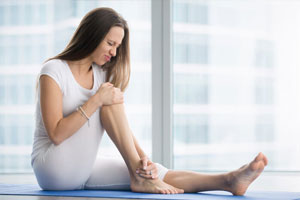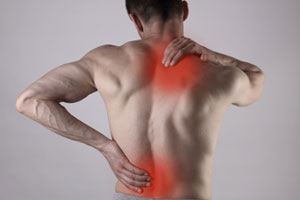If you have frequent muscle spasms, visit Downtown Pain Physicians for the latest non-surgical treatment options including physical therapy, trigger point injections, and nonsteroidal anti-inflammatory drugs. If you suspect that the spasms are related to a spinal condition or a pinched nerve. Downtown Pain Physicians will help you find the cause and develop a treatment plan that’s customized to your needs. Not all muscle spasms are avoidable, but the right diagnosis can make them less frequent and less debilitating. Visit our pain management facility and meet our physicians to get the pain relief you need in the safe, reassuring hands of the top doctors for sports injuries in New York.
Muscle Spasm in the Back, Neck, Leg in Downtown Brooklyn & Lower Manhattan

You’re sleeping soundly and then suddenly your calf muscle cramps up. It’s excruciating and you jump out of bed to stretch your leg and relieve the pain. This is a muscle spasm and most people have experienced them at one point in their lives. They don’t just happen in your calves, but this is a pretty common occurrence. So, what causes muscle spasms, and how do you best manage them?
If you live in the New York City area, a visit to Downtown Pain Physicians can help you pinpoint the cause of your muscle spasms. Your doctor will work with you to determine what is causing your muscle spasms. Some causes are relatively easy to remedy, others require a bit more care and attention. No matter what the cause, learning how to relieve the spasm rapidly will help you in the future. And, if necessary, your doctor will customize a treatment plan that will deal with any underlying issues. A simple twitching muscle spasm almost feels like the muscle is fluttering. It’s very annoying but not usually painful.
What are Muscle Spasms?

Muscle spasms are also often referred to as muscle cramps, a charley horse, or a twitch. They can happen to anyone and can occur for a few seconds or much longer. They are often sudden and involuntary.
When the muscle spasm pulses or twitches it’s actually a series of contractions in the muscle and, while annoying, they typically aren’t painful. They’re also not actually muscle spasm, but they are very similar in many ways.
A true muscle spasm is cramping or seizing of the muscle. It’s often painful and it can be difficult to get the muscle to relax.
Muscle spasms are very common, with most people experiencing them at some point in their lives. They can happen with any muscle but they often occur in the thighs, calves, foot arches, hands, arms, and abdomen.
“VERY KIND”
Dr. Raval is very kind and explains everything in layman’s terms, which is super helpful. Thanks so much, guys! 🙂
“PLEASANT AND PROFESSIONAL”
Best doctor visit I ever had. Staff was pleasant and the doctor was very pleasant and professional. Took his time and answered all my questions.
What’s Happening When I Have a Muscle Spasm?
When you have a muscle spasm, your muscle is forcibly contracting. With a twitch the contractions sort of pulsate. When you have a cramp, the contractions stay tight or rigid. They may even get progressively tighter.
There are a lot of different causes of muscle cramps and sometimes they seem to occur for no reason at all. Typically, it’s an involuntary reaction by your muscle that’s trying to signal that “something is wrong.”
What Does a Muscle Spasm Feel Like?
A simple twitching muscle spasm almost feels like the muscle is fluttering. It’s very annoying but not usually painful.
A cramping muscle spasm is different because it feels like something grabs ahold of your muscle and is squeezing it. The muscle often feels solid and firm, sometimes it’s hot, and it’s quite painful. Because that muscle is so tight, it’s not uncommon for it to feel very sore after the spasm is over.
Symptoms of a Muscle Spasm
If you’re looking for a muscle spasm warning sign or a symptom that can cue you one is coming, there really aren’t any. Some people know that if they do a certain exercise or movement too many times or for too long, they’ll get a cramp. In those situations, the symptom can be the feeling of exhaustion in the muscle, maybe the muscle begins shaking or feeling rubbery before the cramp. Other than that, there really aren’t any signs that a muscle spasm is imminent.
What Causes Muscle Spasms?
There are many different things that can cause a muscle spasm, some are very simple to fix or avoid in the future, others can be serious and require medical attention. If you’re unsure of what’s causing your muscle spasms and you’re having them regularly, a visit to Downtown Pain Physicians is warranted.
Some common causes of muscle spasm can include one or more of the following:
- Low electrolytes. Electrolytes are essential minerals your body needs, like potassium, calcium, and magnesium. Exercise with heavy sweating is one way you can lose electrolytes and it leads to muscle cramps. But you can also lose electrolytes if you’re dehydrated, you’ve been sick, or some medications zap these important minerals. Adding them back to your body through supplements, electrolyte-enriched sports drinks, or even food can help you combat muscle spasms.
- Stress. When people are stressed out, they can tense up their muscles without even realizing they’re doing it. Holding your muscles in a taut position can cause them to fatigue and cramp in response.
- Exhaustion. Your body has a way of letting you know that it’s exhausted, whether it’s from lack of sleep or overwork, muscle spasms and twitches might be your body talking to you.
- Exercise. Exercise can cause muscle cramps in a few different ways, which is why it’s one of the biggest culprits. You’re either straining too much, losing electrolytes, moving or lifting incorrectly, working out in high temperatures, you didn’t properly stretch, or you’re simply wearing your body out.
- Medications, amphetamines, caffeine. All of these contain chemicals that can cause twitches and muscle spasms. Make sure there’s nothing you’re taking regularly that’s causing your muscle concerns. This may require a discussion with your primary doctor if prescriptions are involved.
- Kidney disease. When your kidneys aren’t working as they should, you can develop muscle cramps. There will often be other symptoms, too. Kidney disease can include diabetes or high blood pressure and frequent cramping might mean it’s time for a check-up.
- Pinched spinal nerve. A pinched nerve caused by a disc herniation or other spinal condition can interfere with normal communication between your nerves and muscles, causing muscle spasm. A visit to Downtown Pain Physicians can diagnose this condition and get you on the path to recovery.
- Neuropathy. Damage to the nerves can create a number of symptoms, including cramping, spasms, and twitches. Neuropathy happens any time the nerves are damaged which means that some people are born with it, some develop neuropathy due to illness or injury, and others find that alcoholism and medications are the cause.
Muscle Spasm Risk Factors
Everyone and anyone can get a muscle spasm. In fact, most people experience them in their lifetime. But there are a few risk factors that can make you more predisposed to getting one.
- Dehydration
- Poor muscle tone or weakness
- Overexertion or physical strain
- Injuries or recovering from an injury
- Diet lacking in essential nutrition
- Some illnesses
- Certain medications
- Sciatica
Treatment for Muscle Spasms
Muscle spasms often mean immediate pain and you reach for that muscle instinctively. Your instincts are right, massaging it and stretching out the muscle is the best way to immediately treat a muscle spasm. But that’s not the only thing you can do. Try the following to fix the muscle spasm and prevent further discomfort.
- Stretch. If you can stretch the muscle, this can be the best way to get it to relax and loosen up.
- Physical therapy. Learning some physical therapy techniques specific to your spasms can help you navigate the cramping when it occurs.
- Massage. Sometimes the cramp is in a spot that’s hard to stretch, this is where massaging can be useful. You may also find that a stretch helps, but doesn’t totally relax the muscle, adding manual massage can help you release that muscle spasm.
- Heat. If the muscle is still very tight and tense, applying heat can encourage it to further relax.
- Trigger point injections. When a pain won’t go away or comes back repeatedly, a trigger point injection can be a satisfying solution. Trigger points are small knots of muscle fiber that can be quite tender and painful. A trigger point injection can work as an anti-inflammatory and it can relieve the pain for long-term relief.
- Ice or cold. If the muscle has totally relaxed but there’s a feeling of overexertion or muscle soreness, then cold can relieve some inflammation. It’s key that you don’t apply cold too soon after the spasm.
- Fluids. Make sure you aren’t dehydrated. If that was the cause of the muscle spasm, you may have more if you don’t rehydrate. You might also want to add some electrolytes.
- OTC muscle relaxers. Some people have a lot of soreness after a cramp, an over-the-counter muscle relaxer like ibuprofen can help ease the pain.
If you have frequent muscle spasms, a visit to your doctor might be in order. If you suspect that the spasms are related to a spinal condition or a pinched nerve. Downtown Pain Physicians will help you find the cause and develop a treatment plan that’s customized to your needs. Not all muscle spasms are avoidable, but the right diagnosis can make them less frequent and less debilitating.
Preventing Muscle Spasms in the Future
If you’re looking to avoid having a muscle spasm in the future, there are a few things you can do to help. Keeping your muscles toned and flexible is crucial. If you’re going to exercise, make sure you stretch first so your muscles don’t get overworked and they’re prepared. Even if a workout isn’t in your future, daily stretches will improve muscle flexibility and help you avoid a muscle cramp.
Staying hydrated is another smart way to improve the health of your muscles and the rest of your body, too. If you feel your diet is lacking in key electrolytes, adding a sports drink that’s infused with electrolytes to your daily routine will help.
Speaking of those electrolytes, how about changing your diet a little to add in those key nutrients. Focus on fruits and vegetables to see if you can hit the recommended five servings a day.
Finally, stay on top of your spinal health. If your spine is in good shape, keep it up with regular stretching, proper posture, and using good lifting techniques. If you have some back pain or spinal concerns, Downtown Pain Physicians can address them and help you create a plan for better spinal health.
Do you have any questions about Muscle Spasm Treatment options? Would you like to schedule an appointment with the best pain relief specialists in Downtown Brooklyn and Lower Manhattan? Please call our office for a consultation and indicate which location you want to visit.
-
Dr. Raj Raval, M.D.
- Board Certified
- Interventional Pain & Musculoskeletal Medicine Specialist
-
Education & training
- SUNY Health Science Center
- Rutgers University Fellowship
-
Dr. Raphael Jaramillo, MD
- Board Certified
- Interventional Pain & Musculoskeletal Medicine Specialist
-
Education & training
- Touro College of Osteopathic Medicine
- New York University
- Rutgers University

